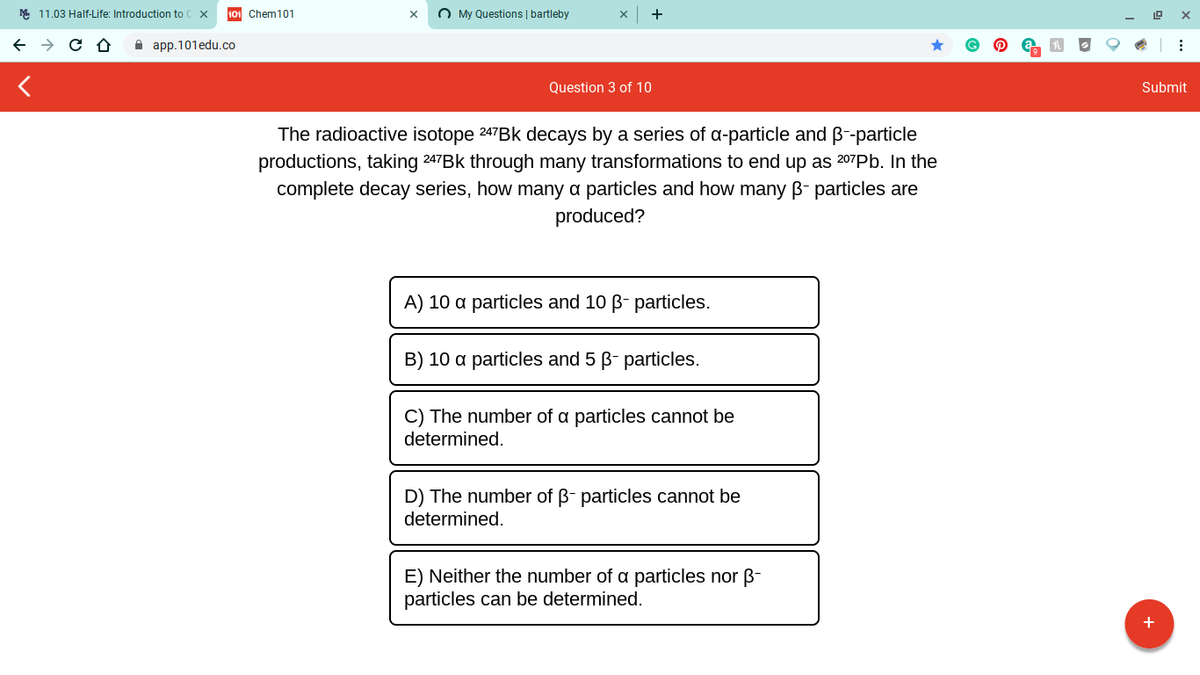The radioactive isotope 247BK decays by a series of a-particle and B-particle productions, taking 247BK through many transformations to end up as 207Pb. In the complete decay series, how many a particles and how many B- particles are produced? A) 10 a particles and 10 B- particles. B) 10 a particles and 5 B- particles. C) The number of a particles cannot be determined. D) The number of B- particles cannot be determined. E) Neither the number of a particles nor ß- particles can be determined.
The radioactive isotope 247BK decays by a series of a-particle and B-particle productions, taking 247BK through many transformations to end up as 207Pb. In the complete decay series, how many a particles and how many B- particles are produced? A) 10 a particles and 10 B- particles. B) 10 a particles and 5 B- particles. C) The number of a particles cannot be determined. D) The number of B- particles cannot be determined. E) Neither the number of a particles nor ß- particles can be determined.
Chemistry & Chemical Reactivity
10th Edition
ISBN:9781337399074
Author:John C. Kotz, Paul M. Treichel, John Townsend, David Treichel
Publisher:John C. Kotz, Paul M. Treichel, John Townsend, David Treichel
Chapter25: Nuclear Chemistry
Section: Chapter Questions
Problem 67IL
Related questions
Question

Transcribed Image Text:M 11.03 Half-Life: Introduction to
101 Chem101
O My Questions | bartleby
A app.101edu.co
Question 3 of 10
Submit
The radioactive isotope 247BK decays by a series of a-particle and B--particle
productions, taking 247BK through many transformations to end up as 207Pb. In the
complete decay series, how many a particles and how many B- particles are
produced?
A) 10 a particles and 10 B- particles.
B) 10 a particles and 5 B- particles.
C) The number of a particles cannot be
determined.
D) The number of B- particles cannot be
determined.
E) Neither the number of a particles nor B-
particles can be determined.
Expert Solution
This question has been solved!
Explore an expertly crafted, step-by-step solution for a thorough understanding of key concepts.
This is a popular solution!
Trending now
This is a popular solution!
Step by step
Solved in 2 steps

Knowledge Booster
Learn more about
Need a deep-dive on the concept behind this application? Look no further. Learn more about this topic, chemistry and related others by exploring similar questions and additional content below.Recommended textbooks for you

Chemistry & Chemical Reactivity
Chemistry
ISBN:
9781337399074
Author:
John C. Kotz, Paul M. Treichel, John Townsend, David Treichel
Publisher:
Cengage Learning

Chemistry & Chemical Reactivity
Chemistry
ISBN:
9781133949640
Author:
John C. Kotz, Paul M. Treichel, John Townsend, David Treichel
Publisher:
Cengage Learning

Introductory Chemistry: An Active Learning Approa…
Chemistry
ISBN:
9781305079250
Author:
Mark S. Cracolice, Ed Peters
Publisher:
Cengage Learning

Chemistry & Chemical Reactivity
Chemistry
ISBN:
9781337399074
Author:
John C. Kotz, Paul M. Treichel, John Townsend, David Treichel
Publisher:
Cengage Learning

Chemistry & Chemical Reactivity
Chemistry
ISBN:
9781133949640
Author:
John C. Kotz, Paul M. Treichel, John Townsend, David Treichel
Publisher:
Cengage Learning

Introductory Chemistry: An Active Learning Approa…
Chemistry
ISBN:
9781305079250
Author:
Mark S. Cracolice, Ed Peters
Publisher:
Cengage Learning

Chemistry
Chemistry
ISBN:
9781305957404
Author:
Steven S. Zumdahl, Susan A. Zumdahl, Donald J. DeCoste
Publisher:
Cengage Learning


Chemistry: An Atoms First Approach
Chemistry
ISBN:
9781305079243
Author:
Steven S. Zumdahl, Susan A. Zumdahl
Publisher:
Cengage Learning